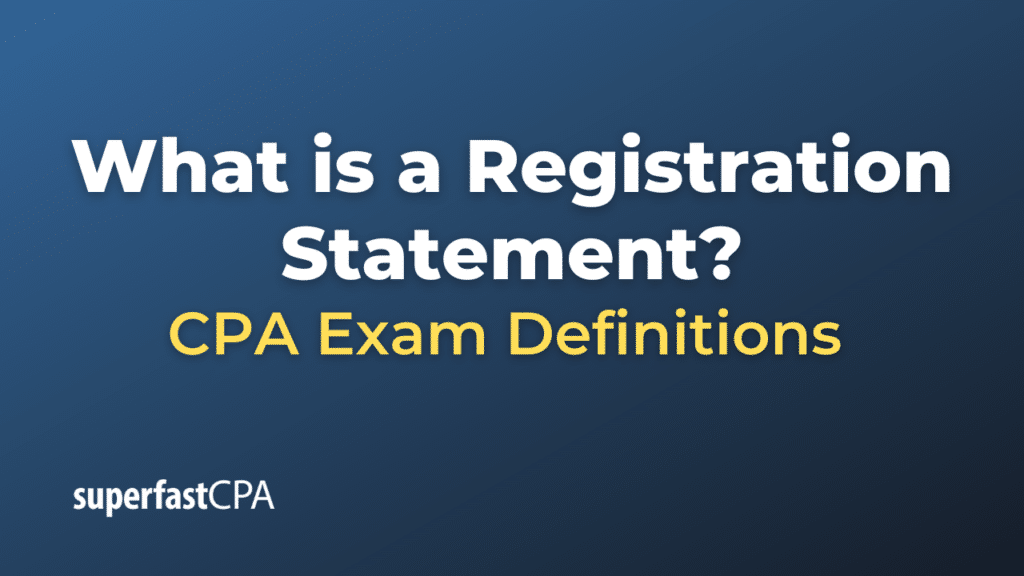Registration Statement
A registration statement is a set of documents, including a prospectus, filed by a company with the Securities and Exchange Commission (SEC) in the U.S. when it plans to issue new securities to the public. The main purpose of the registration statement is to provide potential investors with detailed information about the company’s business, operations, financial condition, management, and the securities being offered, so that investors can make informed decisions.
The registration statement typically includes:
- Business Overview: A description of the company’s operations, products, and services.
- Financial Statements: Audited financial statements that provide insight into the company’s financial health.
- Management’s Discussion and Analysis: A section where the company’s management discusses its recent financial results and future prospects.
- Details about the Offering: Information about the type and number of securities being offered, how the funds raised will be used, and potential risks to investors.
- Information about Management and Major Shareholders : Details about the company’s executive officers, directors, and major shareholders.
- Potential Risks : A comprehensive list of risks associated with the company’s business and the securities being offered.
- Legal Matters: Any ongoing or potential legal issues that could affect the company.
- Other Relevant Information: Other material details that a potential investor should know.
Once a company files a registration statement with the SEC, there’s a “waiting period” during which the SEC reviews the document to ensure it meets regulatory standards and provides adequate disclosure. During this time, the company cannot sell the securities, but it can begin marketing them in what’s known as a “roadshow.”
After the SEC review and once any required amendments are made, the registration statement becomes effective, and the company can begin selling the securities to the public.
One of the most well-known types of registration statements is the Form S-1 , which companies use when they are going public in an initial public offering (IPO). However, there are different forms and types of registration statements depending on the nature of the offering and the issuer.
The requirement for companies to file a registration statement before issuing securities to the public is a cornerstone of U.S. securities laws, ensuring transparency and helping protect investors from potential fraud or misinformation.
Example of a Registration Statement
Let’s walk through a hypothetical example involving a company’s decision to go public with an initial public offering (IPO).
TechFlare, a tech startup specializing in augmented reality applications, has experienced rapid growth in the last few years. To fund further expansion and capitalize on its success, the company’s leadership decides to go public. To do this, TechFlare needs to file a registration statement with the SEC.
- Engage Advisors : TechFlare hires an investment bank to guide them through the IPO process. They also engage a legal team to help with the regulatory aspects.
- Drafting the Registration Statement: Together with its advisors, TechFlare drafts a registration statement, using Form S-1, which is standard for IPOs.
- This document includes a comprehensive overview of TechFlare’s business, a detailed explanation of its technology, audited financial statements, biographies of key executives, plans for the use of IPO proceeds, potential risks to investors, and more.
- The centerpiece of the S-1 is the prospectus, which will be distributed to potential investors. This document gives an overview of the offering and detailed information about the company.
- File with the SEC: TechFlare submits the Form S-1 to the SEC for review.
- Waiting Period: The SEC reviews the document for completeness and compliance with regulations. They may ask questions or require changes.
- During this time, TechFlare can’t sell shares, but they can advertise the upcoming offering and meet with potential investors in a “roadshow.”
- Approval and Effective Date: After a few rounds of feedback and revisions, the SEC declares TechFlare’s registration statement “effective. This means TechFlare can now publicly sell its shares.
- IPO Launch: TechFlare’s shares are offered to the public. With the buzz they generated during their roadshow and the detailed information in their prospectus, the shares are in high demand.
TechFlare successfully raises capital through its IPO, and its shares begin trading on a stock exchange. Investors who purchased shares did so with a clear understanding of the company’s operations, finances, and risks, thanks to the detailed information provided in the registration statement.
This example underscores the importance of the registration statement in ensuring transparency and providing investors with the necessary information to make informed decisions.














